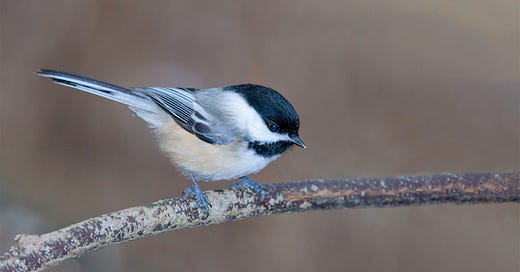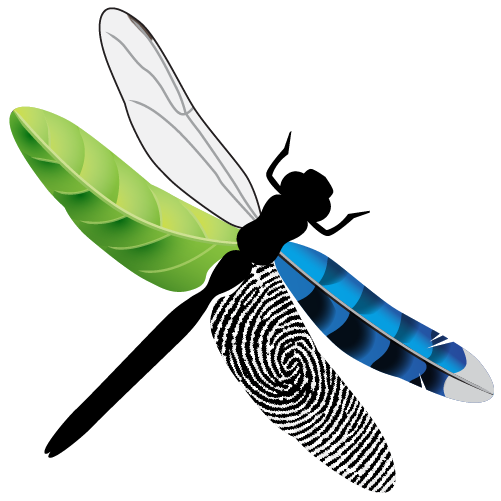DISHONESTY has been in the news of late. And yet long before humans arrived on the scene to tell them, lies have been a way of life on Earth.
Opossums feign death to trick predators. Caterpillars can resemble anything from snakes to twigs to bird shit. And certain plants look like rotting flesh, attracting flies that become unwitting pollinators.
Fraud in nature is evolution in action — wild things doing whatever to get by in the struggle for existence. Humans, of course, lie for their own selfish reasons: survival, lust, demagoguery, greed, cruelty, power.
So what are we to make of birds singing in the midst of winter? After all, songbirds generally make music in the warmth of spring — their time to attract mates and raise young. And yet here in the north, for example, the Black-capped Chickadees have been singing their sweet, plaintive “feee-beee” song of courtship since January.
Global warming? Nope, not really. The chickadees routinely sing in sub-zero temperatures, those brutal days when many of us might otherwise shiver and believe that the cold, like certain humans, can be a force of evil. Even as the spring breeding season remains months off, more birds are erupting into song every day.
And yet I know why the cold bird sings. Not for fraud. Not greed. Not even lust. It’s the light. Now returning to the northern hemisphere, the light remains the most predictable and immutable force of nature in world (or the universe). Even as men in power lie like the rest of us breathe, the songbirds all the while sing a tribute to honesty. And for me, in times of mendacity, faith in light is refuge.
The coming of the light during the cold months has long been noteworthy in human culture. The period falling generally around Groundhog Day and Valentine’s Day, roughly halfway between the Winter Solstice and the Vernal Equinox, has been celebrated for centuries in various secular and religious traditions. Whatever our beliefs or faiths, we humans can see and sense the lengthening days. It’s undeniable.
And so it is for wildlife as well. Day length is a dependable calendar for birds — more so than temperature, especially on a warming planet. During a lengthy January thaw, for example, it would do a songbird no good to begin nesting. Instead, photo-receptors in bird brains note the increasing day length, which triggers the production of hormones that act like birdie aphrodisiacs. The light revives their sexual organs from a state of winter dormancy and initiates an extended period of courtship, including song. So when spring arrives for real, when food is more abundant for their young, birds will be physically ready to breed.
A Mismatch in Nature
Basically, the light is a regulator and safeguard: unlike the climate, day length is something we humans haven’t yet changed (at least not yet). Still, nature is nothing if not complex, and ambient temperature is of course a cue as well for wildlife. As a result, climate change is disrupting wildlife behavior and relationships that have worked in concert for thousands or millions of years — a relatively new eco-concern called the “phenological mismatch.” It amounts to one species, in response to global warming or other impacts, changing its ways, but with another interdependent species failing to adapt accordingly. One oft-cited example is the Pied Flycatcher and its insect prey.
The flycatcher, which winters in Africa, migrates north to Europe in spring to breed and raise its young on a seasonal flush of caterpillars and other insects. But spring now begins earlier in Europe, and along with it the period of caterpillar abundance. Except that the flycatchers in Africa don’t get the memo. They still rely mostly on the light, the increasing day length, to set the timing of their northbound migration. As a result, in some regions of Europe, the flycatchers now arrive and nest too late for peak caterpillar abundance, reducing the survival rates of their nestlings (Both 2006). That’s the phenological mismatch.
Other examples of the mismatch include flowers no longer blooming in sync with the peak flights of their favored insect pollinators, or Arctic plants greening up earlier in the year, depriving caribou calves of the high-quality forage they’ve come to rely on over the course of their evolution. All of it reduces opportunities to thrive.
And now comes a human version — a sudden cultural and political mismatch reducing our own opportunities to thrive. We the people have fallen from the rhythm of nature, which means we’ve fallen from ourselves. Our toys and comforts, our addictions and distractions, weaken a human bond with the natural world that began some 300,000 years ago. No, I’m by no means suggesting that we turn off the machines, quit our jobs, sell our homes, and return to hunting and gathering.
But at the very least, we might find meaning in the light and in the nature it illuminates — including human nature. I’m under no illusion that the increasing light can sanitize the chaos, corruption, and mendacity of our politics. I myself have no easy solutions to offer you for that, other than to fight for beauty, justice, humanity, and nature. (Besides, in the long run, I suspect nature may adjust and fare better with its mismatches than we humans will with ours.)
Regardless, for fortitude and equanimity, I make a point every day to take my leave of the fusillade of news and lies. I turn instead toward the coming of the light. For four-and-a-half billion years it’s been reliable — and still honest. And on these lengthening days, even out in the cold, the chickadees are there with me singing songs of love.
Postscripts and Reference
The poet
, who writes here on Substack, just last week wrote of the phenological mismatch in a poem titled “Because a false spring comes earlier each year.”Where I live in Vermont, day length today (11 Feb 2025) is 2 minutes and 46 seconds longer than yesterday. On the Vernal Equinox (20 Mar 2025), my community will gain 3 minutes and 4 seconds of light. Find your light »
Save the Date: I’ll be joining poets
, who writes , and Angela Patten on April 4 at 7pm for an event called Natural Selections — readings at North Branch Nature Center in Montpelier, Vermont, with music from D. Davis (guitar) and Ruth Einstein (violin).Both, C., Bouwhuis, S., Lessells, C. et al. 2006. Climate change and population declines in a long-distance migratory bird. Nature 441, 81–83, 4 May 2006. https://doi.org/10.1038/nature04539
Agustín Povedano’s Pied Flycatcher image via iNaturalist (CC BY-NC-SA 4.0)







Loved this. Yeah---bit by bit these longer days---me, too, along with the birds, and you, choosing to "...turn instead to the coming of the light."
Some of your finest writing ever. As always, thank you. Today is the day sunshine comes back through out kitchen window, a wonderful time to celebrate and honor life.